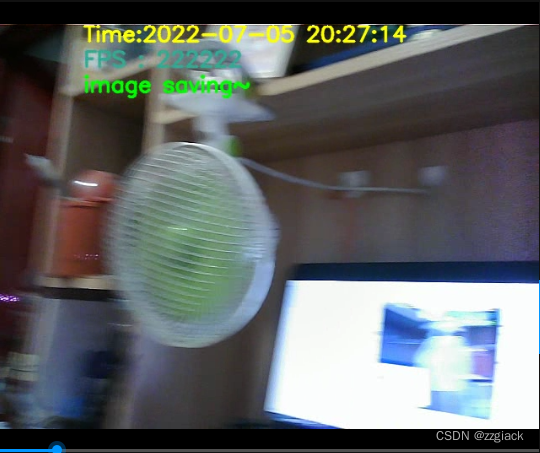1.录制视频并保存
import datetime #显示时间所需模块
import cv2
#创建VideoWriter为写多媒体文件
fourcc = cv2.VideoWriter_fourcc(*'DIVX')
vw = cv2.VideoWriter(".\\out1.mp4",fourcc,25,(640,480))
#创建窗口
cv2.namedWindow('video',cv2.WINDOW_NORMAL)
cv2.resizeWindow('video',640,480) #设置窗口大小
#获取视频设备
cap = cv2.VideoCapture(0)
#cap = cv2.VideoCapture("文件地址") 从文件获取视频
flag = 0
while cap.isOpened(): #判断摄像头是否已打开,若打开返回值则为True
#从摄像头读视频帧
ret,frame = cap.read()
if ret ==True : #判断是否读取到数据
#将视频帧在窗口中显示
#函数执行开始时间
timer = cv2.getTickCount()
#计算fps
fps = cv2.getTickFrequency() / (cv2.getTickCount() - timer)
#显示提示信息(图像,文字内容,坐标,字体,大小,颜色,字体厚度) #cv2.LINE_AA为抗锯齿,看起来会平滑一些
cv2.putText(frame, "FPS : " + str(int(fps)), (100, 50), cv2.FONT_HERSHEY_SIMPLEX, 0.85, (150, 170, 50), 2, cv2.LINE_AA)
#显示时间
datet = str(datetime.datetime.now())[0:19]
cv2.putText(frame, "Time:" + datet, (100, 20), cv2.FONT_HERSHEY_SIMPLEX, 0.85,(0, 255, 255), 2, cv2.LINE_AA)
if flag ==0:
cv2.putText(frame, "image collecting~" , (100, 80), cv2.FONT_HERSHEY_SIMPLEX, 0.85,(0, 255, ), 2, cv2.LINE_AA)
cv2.imshow('video',frame)
cv2.resizeWindow('video',640,480) #重新设置窗口大小
#写数据到多媒体文件
key = cv2.waitKey(1)
# print('flag ==')
# print(flag)
if flag ==1:
# print('开始保存图像')
cv2.putText(frame, "image saving~" , (100, 80), cv2.FONT_HERSHEY_SIMPLEX, 0.85,(0, 255, 0), 2, cv2.LINE_AA)
cv2.imshow('video',frame)
cv2.resizeWindow('video',640,480) #重新设置窗口大小
cv2.waitKey(1 )
vw.write(frame)
if key == 32:#按空格键开始保存图像
vw.write(frame)
flag = 1
# key = cv2.waitKey(1000)
elif (key &0xFF == ord('s')): #按s键停止保存图像
flag =0
print('停止保存图像')
elif(key & 0xFF == ord('q')):#按q键退出
print('结束采集图像')
break
else:
break
#释放资源
cap.release() #释放VideoCapture
vw.release() #释放VideoWrite
cv2.destroyAllWindows() #释放窗口资源
2.读取保存的视频
# -*- coding: utf-8 -*-
from openni import openni2
import numpy as np
import cv2
cv2.namedWindow('video',cv2.WINDOW_NORMAL)
video = cv2.VideoCapture('.\\out1.mp4')
while video.isOpened():
open,frame = video.read()
# print(open)
if open:
# gray = cv2.cvtColor(frame,cv2.COLOR_RGB2GRAY)
# cv2.imshow('video',gray)
# key =cv2.waitKey(10)
# if key ==27:
cv2.imshow('video',frame)
if cv2.waitKey(1) & 0xFF == ord('q'):
break
else:
break
video.release() #释放VideoCapture
cv2.destroyAllWindows() #释放窗口资源
录制效果如下:

当无法正常工作时,通常是由于摄像头的兼容性或驱动问题。
- 尝试使用 CAP_DSHOW 后端
在 Windows 系统中,MSMF 后端有时可能会出现问题,你可以使用 DirectShow (CAP_DSHOW) 后端代替。修改代码如下:
cap = cv2.VideoCapture(0, cv2.CAP_DSHOW)
CAP_DSHOW 通常在 Windows 系统上兼容性更好。尝试这个后端看看是否能解决问题。




 本文介绍如何使用Python和OpenCV录制视频并将其保存到本地文件的方法,同时演示了如何从本地文件读取并播放该视频。
本文介绍如何使用Python和OpenCV录制视频并将其保存到本地文件的方法,同时演示了如何从本地文件读取并播放该视频。

















 2146
2146










